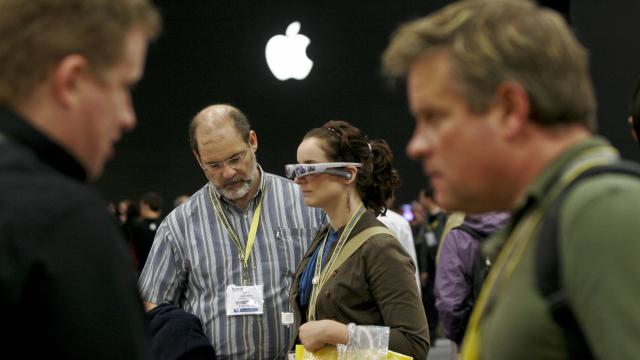Is Apple secretly funding a shadowy shell company to buy up trademarks related to its in-development VR/AR headset? That’s the latest juicy speculation out of the Apple headset rumour mill over at Bloomberg. The new report cites trademark filings in nearly a dozen countries for names like, “Reality One,” “Reality Pro,” and “Reality Processor,” each potentially referencing the company’s highly secretive AR/VR headset expected to be released as early as January 2023. The problem is, those trademark applications weren’t actually filed by Apple; however, Bloomberg argues this wouldn’t be the first time Apple worked with other companies behind the scenes to do its bidding.
Gizmodo couldn’t confirm all of the details in the Bloomberg report and Apple did not immediately respond to our requests for comment, so take all of this with a grain of salt.
Each of the new trademark applications were filed by Immersive Health Solutions LLC, a Delaware-based shell company formed just six months ago, according to Bloomberg. If that doesn’t already sound suspect enough, the publication notes Immersive Health Solutions was registered by the ominously named “Corporation Trust Co,” which Bloomberg notes is often used by companies looking to avoid unwanted detention. Corporation Trust Co, was reportedly involved earlier this year in filing a trademark for “realityOS.”
Believe it or not, rumours surrounding the supposed “realityOS” operating system actually date back to at least 2017. That initial rumour, also coming by way of Bloomberg, claimed the rumoured operating system, also referred to as “rOS” is based off of iOS and would power Apple’s headset.
Immersive Health Solutions LLC and Corporation Trust Co did not immediately respond to Gizmodo’s requests for comment.
Trademarks were reportedly filed in the U.S., UK, EU, Canada, Saudi Arabia, Australia, New Zealand, Costa Rica, and Uruguay. In three of those countries — the U.S., Canada, and New Zealand — the filings reportedly relied on law firms Apple has previously used to file trademarks. The report claims Apple often uses this approach to secretly buy up patents ahead of time to avoid having to spend big to purchase them back from other companies once they have products ready to launch.
What we think we know about Apple’s headset so far
Apple’s mixed reality headset, along with its beleaguered car fiasco, are among the two worst kept secrets in tech. The company still hasn’t officially announced the headset, but just about everyone in the VR/AR space is bracing themselves for the product to launch and send shockwaves through the industry. Analysts predict the high-powered standalone mixed reality device could ship as early as next year with a $US2,000 ($2,776) price tag. Previous reports suggest it could cost as much as $US3,000 ($4,165). That would make it easily one of the more expensive consumer headsets on the market. For context, Meta’s Quest 2, the most popular consumer headset, just bumped up in its price to $US499 ($693).
When Apple does release its first headset, analyst Ming-Chi Kuo predicts it will limit its release to around 1.5 million units. On the spec side of things, the device could feature 8K displays, M1 Pro-level power, and come decked out with 14 built-in cameras. Apple’s headset is expected to combine dual 4K OLED microdisplays and at least six optical modules to provide continuous, “video see-through AR services.”
The recent trademarks also provide a few additional hints of what to expect with Apple’s headset. For starters, the “Reality One” and “Reality Pro” trademarks could suggest Apple’s interest in launching multiple tiers of its headset as it does with other products like the iPhone and Watch. Bloomberg notes the “Reality Processor” trademark could also potentially refer to a new custom silicon chip designed specifically for the headset. Then again, Apple could be filling multiple trademarks to cover their bases rather than worry about buying having to buy them later.
And even though the company hasn’t even officially announced its first headset, we’ve already started learning some new details about its second generation headset. That headset, which could ship sometime in the first half of 2025, will reportedly come with a micro OLED panel supplied by LG. Sony’s reportedly supplying the displays for the Mk1 version. That second model may also reportedly ship with both a high end and slightly more affordable version.
